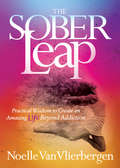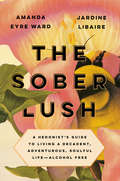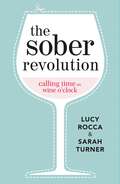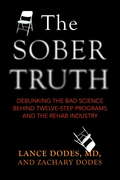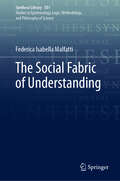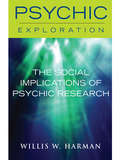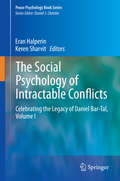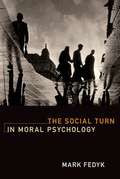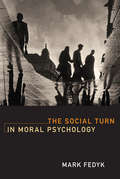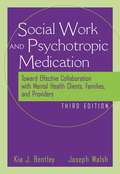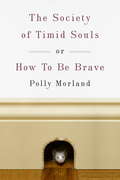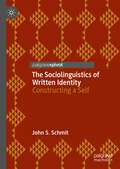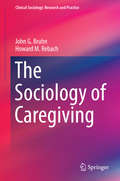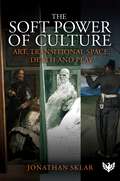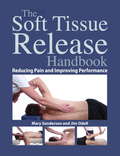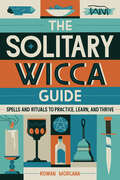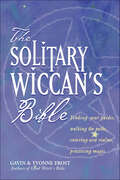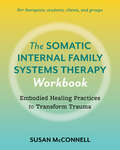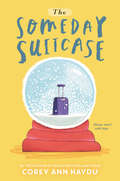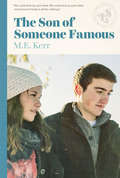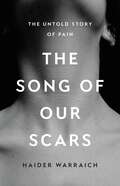- Table View
- List View
The Sober Leap: Practical Wisdom to Create an Amazing Life Beyond Addiction
by Noelle Van VlierbergenThe Sober Leap helps recovering addicts take their recovery to the next level. Millions of women enter recovery from alcohol addiction with one goal in mind: to stay sober. They&’re left to their own devices to &“figure it out&” from there, leaving them feeling lost, disenchanted, and susceptible to relapse. The Sober Leap invites recovering addicts to step into the light and thrive in recovery. Certified Health and Addiction Recovery Coach Noelle Van Vlierbergen provides practical wisdom to change the habits and behaviors that are holding readers back from showing up fully as a powerful, sober woman. With honesty and humor, Noelle shares her own experiences with recovery and introduces readers to eleven basic principles that will transform the mind, body, and soul. Reintroducing readers to the truths they&’ve always known, but lost along the way, The Sober Leap is a call to action to let go of the past, embrace the present, and finally start living the life you were meant to live.
The Sober Lush: A Hedonist's Guide to Living a Decadent, Adventurous, Soulful Life--Alcohol Free
by Jardine Libaire Amanda Eyre WardA sober hedonist's guide to living a decadent, wild, and soulful life--alcohol-free.In a culture where sipping "rosé all day" is seen as the epitome of relaxation, "grabbing a drink" the only way to network; and meeting at a bar the quintessential "first date," many of us are left wondering if drinking alcohol really is the only way to cultivate joy and connection in life.Jardine Libaire and Amanda Eyre Ward wanted to live spontaneous and luxurious lives, to escape the ordinary and enjoy the intoxicating. Their drinking, however, had started to numb them to the present moment instead of unlocking it. Ward was introduced to Libaire when she first got sober. As they became friends, the two women talked about how they yearned to create lives that were Technicolor, beautifully raw, connected, blissed out, and outside the lines . . . but how? In The Sober Lush, Libaire and Ward provide a road map for living a lush and sensual life without booze. This book offers ideas and instruction for such nonalcoholic joys as: • The allure of "the Vanish," in which one disappears early from the party without saying goodbye to a soul, to amble home under the stars • The art of creating zero-proof cocktails for all seasons • Having a fantastic first date while completely sober • A primer on setting up your own backyard beehive, and honey tastingsFor anyone curious about lowering their alcohol consumption or quitting drinking altogether, or anyone established in sobriety who wants inspiration, this shimmering and sumptuous book will show you how to keep indulging in life even if you stop indulging in alcohol.
The Sober Revolution: Calling Time on Wine O'Clock (Addiction Recovery Ser. #1)
by Lucy Rocca Sarah TurnerDo you count down the minutes to wine o’clock on a daily basis? Is a bottle of Pinot Grigio your friend at the end of a long hard day? If you want to give up being controlled and defined by alcohol then now is the time to join The Sober Revolution…Fed up of living in a fog of hangovers, lethargy and guilt from too much wine? Have you tried to cut down without success?You are not alone. When it comes to alcohol, millions of people around the world find it hard to exercise moderation and become stuck in a vicious cycle of blame, guilt and using more alcohol as a way of coping.The Sober Revolution looks at women and their relationships with alcohol, exploring the myths behind this socially acceptable yet often destructive habit. Rather than continuing the sad spiral into addiction it helps women regain control of their drinking and live happier, healthier lives.Sarah Turner, cognitive behavioural therapist and addictions counsellor, and Lucy Rocca, founder of Soberistas.com, the popular social networking site for women who have successfully kicked the booze or would like to, give an insight into ways to find a route out of the world of wine.The Sober Revolution will open your eyes to the dangers of social drinking and give you the tools you need to have a happy life without the wine. Read it now and call time on wine o’clock forever.
The Sober Revolution: Calling Time on Wine O'Clock (Addiction Recovery Series #1)
by Lucy Rocca Sarah TurnerDo you count down the minutes to wine o’clock on a daily basis? Is a bottle of Pinot Grigio your friend at the end of a long hard day? If you want to give up being controlled and defined by alcohol then now is the time to join The Sober Revolution…Fed up of living in a fog of hangovers, lethargy and guilt from too much wine? Have you tried to cut down without success?You are not alone. When it comes to alcohol, millions of people around the world find it hard to exercise moderation and become stuck in a vicious cycle of blame, guilt and using more alcohol as a way of coping.The Sober Revolution looks at women and their relationships with alcohol, exploring the myths behind this socially acceptable yet often destructive habit. Rather than continuing the sad spiral into addiction it helps women regain control of their drinking and live happier, healthier lives.Sarah Turner, cognitive behavioural therapist and addictions counsellor, and Lucy Rocca, founder of Soberistas.com, the popular social networking site for women who have successfully kicked the booze or would like to, give an insight into ways to find a route out of the world of wine.The Sober Revolution will open your eyes to the dangers of social drinking and give you the tools you need to have a happy life without the wine. Read it now and call time on wine o’clock forever.
The Sober Shift: A Modern-Day Guide to Living an Abundant Sober Life
by Suzanne WaryeLive fully, abundantly, and free every day without alcohol with this inspiring guide from wellness writer Suzanne Warye, the creator behind the Sober Mom Life podcast and My Kind of Sweet. Waking up with another hangover as the thirty-nine-year-old mother of a newborn, Suzanne Warye decided enough was enough. It was time to quit alcohol for good. In the years since, Suzanne has uncovered the myth of moderation and the limitations of the hitting rock bottom narrative. Today, she is a model for hundreds of thousands of people around the world who are embracing her brand of joyful sobriety.Too many of us are taught not to question or examine our relationship with drinking until we’re addicted, or until we experience an intervention or another life-shattering consequence. We’re encouraged to enjoy this highly addictive substance “responsibly.” The Sober Shift is about finding true abundance—as a better partner and a more present parent, and as the architect of a life you love—without buying into the lies of “wine o’clock.”Suzanne knows that many of us fear that, without the crutch of alcohol, we might not know how to relax, decompress, or spend quality time with our loved ones. She’s been there. And she’s here to tell you that a good life awaits when we walk away from the bottle. Written with her trademark flair and engaging sense of humor, blending memoir with takeaways and cultural insights, and featuring delicious mocktail recipes to celebrate the seasons—including Virgin Rosemary Moscow Mule, Sparkling Thyme Cider, Cranberry Orange Fizz, Tart Cherry Spritz, and The Soberita—this affirming guide will help you find freedom from alcohol.Your life is waiting on the other side.
The Sober Truth
by Zachary Dodes Lance DodesAn exposé of Alcoholics Anonymous, 12-step programs, and the rehab industry--and how a failed addiction-treatment model came to dominate America. AA has become so infused in our society that it is practically synonymous with addiction recovery. Yet the evidence shows that AA has only a 5-10 percent success rate--hardly better than no treatment at all. Despite this, doctors, employers, and judges regularly refer addicted people to treatment programs and rehab facilities based on the 12-step model. In The Sober Truth, acclaimed addiction specialist Dr. Lance Dodes exposes the deeply flawed science that the 12-step industry has used to support its programs. Dr. Dodes analyzes dozens of studies to reveal a startling pattern of errors, misjudgments, and biases. He also pores over the research to highlight the best peer-reviewed studies available and discovers that they reach a grim consensus on the program's overall success. But The Sober Truth is more than a book about addiction. It is also a book about science and how and why AA and rehab became so popular, despite the discouraging data. Dr. Dodes explores the entire story of AA's rise, from its origins in early fundamentalist religious and mystical beliefs to its present-day place of privilege in politics and media. The Sober Truth includes true stories from Dr. Dodes's thirty-five years of clinical practice, as well as firsthand accounts submitted by addicts through an open invitation on the Psychology Today website. These stories vividly reveal the experience of walking the steps and attending some of the nation's most famous rehabilitation centers. The Sober Truth builds a powerful response to the monopoly of the 12-step program and explodes the myth that these programs offer an acceptable or universal solution to the deeply personal problem of addiction. This book offers new and actionable information for addicts, their families, and medical providers, and lays out better ways to understand addiction for those seeking a more effective and compassionate approach to this treatable problem. From the Hardcover edition.
The Social Fabric of Understanding (Synthese Library #501)
by Federica Isabella MalfattiThis book is a journey of in-depth exploration into the social dimensions of understanding. As human beings, we strive to understand the world around us. The path to understanding, however, is rarely walked alone; we walk the path with others. We understand more together, by joining forces, than we would understand alone. When we understand something and come to see things clearly, it is probably because someone else has taught us, enlightened us, shared his or her perspective with us, or shaped our environment so that our attempts to make sense of the world were likely to succeed. Understanding, then, is a social rather than an individual achievement. The book will be of great interest to philosophers working in epistemology, philosophy of science, and the philosophy of education.
The Social Implications of Psychic Research
by Willis W. HarmanPsychic research, both as a formal discipline within the activity of science and as an informal fascination and exploration in the larger culture, is profoundly affecting habitual modes of thinking and perceiving, and thence social institutions and the culture itself. The characteristics of this paradigm shift are examined in terms of the Perennial Philosophy and the New Freemasonry, and the significance of this view of man in the universe if it were to become dominant is suggested in this final chapter of Psychic Exploration. The full volume of Psychic Exploration can be purchased as an ebook or paperback version from all major online retailers and at cosimobooks.com.
The Social Institution of Discursive Norms: Historical, Naturalistic, and Pragmatic Perspectives (Routledge Studies in Contemporary Philosophy)
by Hans Bernhard Schmid Preston Stovall Leo TownsendThe essays in this collection explore the idea that discursive norms—the norms governing our thought and talk—are profoundly social. Not only do these norms govern and structure our social interactions, but they are sustained by a variety of social and institutional structures. The chapters are divided into three thematic sections. The first offers historical perspectives on discursive norms, including a chapter by Robert Brandom on the way Hegel transformed Kant’s normativist approach to representation by adding both a social and a historicist dimension to it. Section II features four chapters that examine the sociality of normativity from within a broadly naturalistic framework. The third and final section focuses on the social dimension of linguistic phenomena such as online speech acts, oppressive speech, and assertions. The Social Institution of Discursive Norms will be of interest to scholars and advanced students working in philosophy of language, philosophy of mind, and social philosophy.
The Social Psychology of HIV Infection (Psychology Library Editions: Social Psychology)
by John Pryor Glenn ReederIn the early 1980s we witnessed the birth of one of the most complex and perplexing social problems faced by modern society: the epidemic of infection with human immunodeficiency virus (HIV), which causes acquired immunodeficiency syndrome (AIDS). Originally published in 1993 this title looks at the social psychology surrounding HIV and AIDS. The organization of the volume centres upon two themes: The Theoretical Roots of Prevention and The Dilemma of the PWA (person with AIDS). The goal of this volume is not to evaluate previous attempts to answer these social problems, but to provide theoretical analyses of some of the basic sociopsychological processes that underlie the problems. Over 20 years on this is a snapshot of research into HIV and AIDS and attitudes of the time looking at social problems that are very much still with us.
The Social Psychology of Intractable Conflicts
by Eran Halperin Keren SharvitThis volume works explores a transferable theory of a specific social-psychological infrastructure, based on the work of Dr. Daniel Bar-Tal, that develops from cultures immersed in intractable conflicts. The book's approach to this issue is different from approaches that are predominant in social psychology. This is because an important inspiration of many scholars that contributed to the book is their everyday experience of living in a region where intractable conflict shapes the life's of everybody who lives there. On the basis of this experience and on the basis of extensive research, an elaborate theory of intractable conflict was developed that deals with the origin of such conflicts, the mechanisms that maintain them and the processes that may contribute to their peaceful solution. In light of recent research and developments, this volume demonstrates, analyzes and reviews the theory of a social-psychological infrastructure formed in societies with intractable conflicts. It explores the contents of these elements of the infrastructure, the processes through which they are acquired and maintained, their functions, the societal mechanisms that contribute to their institutionalization, as well as their role in the crystallization of social identity and development of a culture of conflict. By demonstrating that it can be applied to various kinds of intractable conflicts in various places of world, the volume argues that the theory is transferable and universal. Moreover, the volume aims to exhibit new connections and integrations between Bar-Tal's theories and other prominent theoretical frameworks in social and political psychology. Presenting both a comprehensive overview of works that have been influenced by Bar-Tal's theories and research, as well as a wide gate to future studies that will connect Bar-Tal's work to recent theoretical developments in related domains, Understanding the Social Psychology of Intractable Conflicts: Celebrating the Legacy of Daniel Bar Tal is an important text for all those interested in developing a sustainable, peaceful world.
The Social Turn in Moral Psychology
by Mark FedykIn this book, Mark Fedyk offers a novel analysis of the relationship between moral psychology and allied fields in the social sciences. Fedyk shows how the social sciences can be integrated with moral philosophy, argues for the benefits of such an integration, and offers a new ethical theory that can be used to bridge research between the two. Fedyk argues that moral psychology should take a social turn, investigating the psychological processes that motivate patterns of social behavior defined as ethical using normative information extracted from the social sciences. He points out methodological problems in conventional moral psychology, particularly the increasing methodological and conceptual inconsilience with both philosophical ethics and evolutionary biology. Fedyk's "causal theory of ethics" is designed to provide moral psychology with an ethical theory that can be used without creating tension between its scientific practice and the conceptual vocabulary of philosophical ethics. His account aims both to redirect moral psychology toward more socially realistic questions about human life and to introduce philosophers to a new form of ethical naturalism -- a way of thinking about how to use different fields of scientific research to answer some of the traditional questions that are at the heart of ethics.
The Social Turn in Moral Psychology (The\mit Press Ser.)
by Mark FedykAn argument that moral psychology can benefit from closer integration with the social sciences, offering a novel ethical theory bridging the two.In this book, Mark Fedyk offers a novel analysis of the relationship between moral psychology and allied fields in the social sciences. Fedyk shows how the social sciences can be integrated with moral philosophy, argues for the benefits of such an integration, and offers a new ethical theory that can be used to bridge research between the two. Fedyk argues that moral psychology should take a social turn, investigating the psychological processes that motivate patterns of social behavior defined as ethical using normative information extracted from the social sciences. He points out methodological problems in conventional moral psychology, particularly the increasing methodological and conceptual inconsilience with both philosophical ethics and evolutionary biology. Fedyk's “causal theory of ethics” is designed to provide moral psychology with an ethical theory that can be used without creating tension between its scientific practice and the conceptual vocabulary of philosophical ethics. His account aims both to redirect moral psychology toward more socially realistic questions about human life and to introduce philosophers to a new form of ethical naturalism—a way of thinking about how to use different fields of scientific research to answer some of the traditional questions that are at the heart of ethics.
The Social Worker and Psychotropic Medication: Toward Effective Collaboration with Mental Health Clients, Families, and Providers (3rd edition)
by Joseph Walsh Kia J. BentleyIntended for social workers who want to understand the drugs prescribed to their clients, this text describes the central nervous system, the basic principles of pharmacology, and the specific disorders treated by antipsychotics, antidepressants, mood stabilizers, anti-anxiety drugs, and psychostimulants. The third edition reflects new medications and new uses of medications across diagnostic categories.
The Society of Timid Souls
by Polly MorlandA journey into the modern life of an ancient virtue - bravery - and a quest to understand who might possess it and how With The Society of Timid Souls, or How To Be Brave, documentary filmmaker Polly Morland sets out to investigate bravery, a quality that she has always felt she lacked. The book takes inspiration from a vividly eccentric, and radical, self-help group for stage-frightened performers in 1940s Manhattan, which coincided with the terrifying height of World War II and was called The Society of Timid Souls. Seventy years later, as anxiety about everything from terrorism to economic meltdown continues, Morland argues that courage has become a virtue in crisis. We are, she says, all Timid Souls now. Despite a career in which she has filmed in rebel-held Colombian jungles and at the edge of Balkan mass graves, interviewing convicted murderers, drug-traffickers, and terrorists, Morland herself has never felt brave. Often, the very reverse. So she sets out to discover how and why courage is achieved in an age of anxiety and whether it might even be learned. Drawing on her interviews and encounters with soldiers and civilians, bullfighters and big-wave surfers, dissidents fighting for freedom and cancer patients fighting for their lives, Morland examines bravery across the spectrum: from the first childhood act of defiance by Bernard Lafayette, a leader of the civil rights movement who later faced down the KKK in Alabama, or the reflexive will-to-survive of Vjollca Berisha, a Kosovo Albanian who endured a massacre by playing dead among the bodies of her own family, to the small acts of everyday bravery that quietly punctuate our lives, in schoolyards, labor wards, and hospices the world over. Along the way, Morland draws attention to some of the myths of bravery that have been conjured and perpetuated over time and argues that, often, courage exists as much in the telling as in the doing. At once an exploration of what bravery means and a chronicle of the author's personal journey among those who embody it, The Society of Timid Souls is a profound, approachable meditation on this most valued and mysterious of human qualities. In setting off on the trail of the lionhearted, Polly Morland finds out a great deal about what makes some of us extraordinary, and what of the extraordinary we all share.From the Hardcover edition.
The Sociolinguistics of Written Identity: Constructing a Self
by John S. SchmitThis book examines the ways in which a writer’s presentation of self can achieve or impede access to power. Conversations about written voice and style have traditionally revolved around the aesthetics of stylistic choice. These choices, while they help establish a writer’s presence in a text, too often ignore the needs of written identity as it crosses genres, disciplines, and rhetorical purposes. In contrast to stylistic investigations of a writer’s "voice" and its various components—diction, detail, imagery, syntax, and tone, for example—this book focuses on language variation and the linguistic features of a writer’s presence in a text, as well as the establishment of a writer’s social, cultural, and personal identity in a given text. The author attempts to explain the methods by which writers present themselves to their audiences. This book will be of particular interest to students and teachers of rhetoric and composition studies, as well as writers more broadly.
The Sociology of Caregiving
by John G. Bruhn Howard M. RebachThis volume conceptualizes caregiving as an emerging sociological issue involving complex and fluctuating roles. The authors contend that caregiving must be considered in the context of the life span with needs that vary according to age, developmental levels, mental health needs and physical health demands of both caregivers and care recipients. As the nature and functions of caregiving evolve it has become a critical and salient issue in the lives of individuals in all demographic, socioeconomic and ethnic categories. This volume frames caregiving as a sociological issue and addresses a number of central concerns, such as: - Caregiving is a life span experience associated with aging and the roles of spouses and adult children. - Caregiving involves a complex of social system variables that influence the social support and services to caregivers and care recipients. - The nature of the relationship among family caregivers, professional caregivers and the care recipient are embedded in their interaction and dynamics influenced by the internal and external variables that inhibit or facilitate the care situation. - How can caregiving be integrated with a public health agenda? - What disparities or inequalities exist in caregiving and what are the barriers that sustain them? - What community-based interventions need to be developed to improve caregiving?
The Soft Power of Culture: Art, Transitional Space, Death and Play
by Jonathan SklarPsychoanalysis is a valuable tool to add to the sciences and the arts: all contain unconscious hidden depths that can become insight and understanding and contribute to humanity as culture. Using the prism of art, music, and storytelling, Jonathan Sklar takes psychoanalytic thought to a wide audience to enable a greater understanding of humanity.
The Soft Tissue Release Handbook
by Mary Sanderson Jim OdellFor practitioners of massage therapy, sports massage, remedial massage, and physical therapy, soft tissue release is a powerful tool in treating chronic pain conditions such as shoulder impingement, tennis elbow, and iliotibial band friction syndrome. Soft tissue release also aids post-surgical recovery and is used in the treatment of highly trained athletes, dancers, and musicians who wish to tackle those small but key tissue areas needed to maintain and improve their performance. The soft tissues consist of muscle fibers, myofascia, tendons, and ligaments. The all-encompassing nature of this connective tissue is becoming increasingly fascinating to bodywork practitioners of all kinds, including massage therapists, physical therapists, chiropractors, osteopaths, orthopedic nurses and doctors, and sports therapists. Treatment of the soft tissues continues to gain momentum, and there are many exciting research developments that demonstrate how manipulation of these tissues can have profound effects on the structure and function of the musculoskeletal system. Skilled release of the soft tissues reduces the need for adjustments or joint mobilizations, because appropriate release improves joint movement. Freeing the joints and enhancing the health of the soft tissues also facilitates a superior and lasting response to rehabilitation programs. The Soft Tissue Release Handbook is aimed at practicing therapists who wish to address the soft tissues precisely and effectively, whether as an adjunct to existing bodywork techniques or as a treatment modality in itself. The skills presented in this book can be immediately applied in the clinic with existing and new clients. Graphic illustrations of the key muscles involved in movement, as well as over 200 full-color photographs of the technique in action, make this an easy-to-use and practical guide.
The Solitary Wicca Guide: Spells and Rituals to Practice, Learn, and Thrive
by Rowan MorganaEmpower yourself and enrich your life with spells and rituals for the Solitary Wiccan Wicca centers around harmony, balance, wholeness, and a reverence for all living things. The Solitary Wicca Guide gives you the freedom to choose how you practice and where your magick takes you. You'll find spells to help you grow more enlightened every day and focus on bettering each moment through your magickal work. Build your Solitary Wicca practice with an overview of Wiccan deities, guidance on drawing out organic power, and ways to embrace the elements no matter where you live. Learn to set up an altar with essentials before exploring more than 100 spells to improve your magickal life and the lives of those around you, as well as celebrating the seasons and lunar cycles. You'll even find appealing celebratory recipes, like Cupid's Carrot Cake, and personalized charms and potions perfect for gifting. The Solitary Wicca Guide includes: Magickal roots—Explore the belief system and benefits of Solitary Wicca with an overview of Wicca's history, its spiritual connection to the natural world, and how to honor nature whether you're in the country, town, or city. At the altar—From cleansing to consecration, you'll find enlightening illustrations to help set up your altar for solo work, including herbs you'll be working with and common Wicca ceremonial tools. Wicca for one—Empower yourself with 100+ spells, rituals, recipes, and magickal preparations, including Self-Healing Spell, Yule Sabbat Ritual, Chocolate Mousse Happiness Spell, and a Rosebud Love Salve. Deepen your faith daily with Solitary Wicca as you cast your own path for a better life.
The Solitary Wiccan's Bible: Finding Your Guides, Walking the Paths, Entering New Realms, Practicing Magic
by Gavin FrostThe key to all Wiccan practice is ultimately solitary because developing real growth and awareness begins inside each individual. The Solitary Wiccan's Bible is for any reader wanting to go deeper into his or her understanding and experience of Wicca--alone. There are many reasons people seek a solitary path: fear of charlatans, concern about co-workers finding out or being misunderstood by others, or lack of family or social support for Wiccan practice.The Solitary Wiccan's Bible uses the metaphor of a solitary pilgrim walking a path and discovering natural and spiritual truths along the way. This pilgrimage is based on the ancient symbology of the Pentagram enclosed in the triple circle. The Solitary Wiccan's Bible leads the pilgrim to cross the circles, moving from the Wilderness through the Home and Astral realms, to achieve the central Spiritual realm. Always down-to-earth and easy to understand, The Solitary Wiccan's Bible clearly lays out the Wiccan paths so any reader can follow.Chapters include:* The Pilgrimage of Wicca* The Pilgrim Enters New Realms* The Pilgrimage of the Pentagram* The Pilgrim's Wiccan Magical Path* The Practical Pilgrim's Spellwork* The Pilgrim's TalismansThe Solitary Wiccan's Bible provides background and practice in clear, accessible, and often humorous prose, making the book immediately useful to first-time seekers and long-time practitioners alike.
The Somatic Internal Family Systems Therapy Workbook: Embodied Healing Practices to Transform Trauma--For therapists, students, clients, and groups
by Susan McConnellThe companion workbook to Somatic Internal Family Systems Therapy—a practical guide to the 5 pillars of embodied IFS for trauma therapists, Somatic Experiencing™ practitioners, and mental health healersWith embodied exercises, foundational knowledge, and practical guidance, The Somatic Internal Family Systems Therapy Workbook shows therapists and clinicians how to embody the five practices of Somatic IFS: somatic awareness, conscious breathing, radical resonance, mindful movement and attuned touch.Each works together to facilitate trauma healing with clients and build embodied safety, integrate unresolved harm, and develop the ability to name, process, and understand emotional and somatic sensations. The workbook opens by inviting the therapist to explore their own Internal System, offering an embodied approach to experiencing the model. Chapter 1 explores and explains foundational concepts like somatics; embodiment; Parts; Self; and the cultural influences that shape and shift our embodied experiences. Chapters 2 - 6 move into theoretical grounding, clinical applications, and practical exercises for each of the five principles. They offer tools to:Develop clients' ability to name, describe, and convey sensationsRecognize and track for signs of client overwhelmWork with Parts that fear body awarenessUnderstand the purpose and clinical benefits of conscious breathingRestore the Embodied Self Explore therapeutic shifts from doing to to being with clientsHeal attachment woundsIntegrate mindful movement into healing developmental traumaUnderstand and practice attuned touchEach practice is designed to be used whenever it will be of benefit: the tools and exercises are non-linear and adaptable, and aren&’t limited by a prescriptive sequence. The workbook also explores links between current psychotherapeutic practice and ancient healing modalities, grounding SIFS in a larger web of effective somatic trauma healing and embodiment approaches.
The Someday Suitcase
by Corey Ann HayduReaders who loved The Thing About Jellyfish and Goodbye Stranger will find a mysterious magic and unforgettable friendship in The Someday Suitcase, written by the critically acclaimed author of Rules for Stealing Stars.Clover and Danny are the kind of best friends who make each other even better. They’re so important to each other that Clover believes they’re symbiotic: her favorite science word, which describes two beings who can’t function without the other. But when Danny comes down with a mysterious illness that won’t go away, the doctors can’t figure out what’s wrong with him. So Clover decides to take matters into her own hands by making lists—list of Danny’s symptoms, his good days, his bad days. As the evidence piles up, only one thing becomes clear: Danny is only better when Clover is around.Suddenly it feels like time is running out for Clover and Danny to do everything they’ve planned together—to finally see snow, to go on a trip with the suitcase they picked out together. Will science be able to save Danny, or is this the one time when magic can overcome the unthinkable?
The Son Of Someone Famous
by M. E. KerrThough to Brenda Belle Blossom's mother he is just "that boy . . . tying those beer cans to the Christmas tree," sixteen-year-old Adam is really the son of a famous movie star who hobnobs with royalty while jetting all over the world. Smarty Brenda Belle Blossom, horrified by fuzz on her upper lip, cracks jokes to avoid the bummer of her teeny Vermont hamlet and ladylike mother. When Adam is expelled from his last boarding school, he washes up in Vermont to stay with his irascible, alcoholic grandfather, and meets Belle at the drug store. Soon they are going steady, calling each other "darling," and dedicated to helping other misfits achieve "Nothing Power"--until Brenda realizes there's more to the "ordinary" Adam than it seems.M.E. Kerr is the winner of the 1993 Margaret Edwards Award for her lifetime achievement in writing books for young adults. She has been described by the New York Times Book Review as "one of the grand masters of young adult fiction." She lives in Long Island, New York.
The Song of Our Scars: The Untold Story of Pain
by Haider WarraichA doctor&’s personal and unsparing account of how modern medicine&’s failure to understand pain has made care less effectiveIn The Song of Our Scars, physician Haider Warraich offers a bold reexamination of the nature of pain, not as a simple physical sensation, but as a cultural experience.Warraich, himself a sufferer of chronic pain, considers the ways our notions of pain have been shaped not just by science but by politics and power, by whose suffering mattered and whose didn&’t. He weaves a provocative history from the Renaissance, when pain transformed into a medical issue, through the racial legacy of pain tolerance, to the opiate epidemics of both the nineteenth and twenty-first centuries, to the cutting edge of present-day pain science. The conclusion is clear: only by reckoning with both pain&’s complicated history and its biology can today&’s doctors adequately treat their patients&’ suffering.Trenchant and deeply felt, The Song of Our Scars is an indictment of a broken system and a plea for a more holistic understanding of the human body.
